 |
| Curly dock |
Some of the more common greens in our area are the docks- curly dock (Rumex crispus) and broad leaf dock (Rumex obtsifolius). Dock greens are not tender enough to eat raw as a salad for most people, but they are tough enough to stand up to cooking as a pot herb. Essentially, you can chop them and add them to soups, curries, stews, casseroles, and any other place you might have used another green like kale or cooked spinach.
 |
| Broad leaf dock |
We made the filling to this recipe two ways, once with curly dock, once with broad leaf dock. The filling made with curly dock had a sour/tangy taste, almost lemony, and was a bit more tender. The filling made with broad leaf dock was slightly bitter, and the texture was more substantial and toothsome. Both fillings were excellent, so make the buns with whatever dock you have, or to fit you tastes. We like both sour greens and bitter greens, so we would make them both again with the abundance of free, local, and fresh wild foraged dock in our area. As usual, this is a vegetarian recipe. We used some re-hydrated Hen of the Woods mushrooms, but you could use some shiitake or white buttons. You will need a bamboo steamer and some parchment or wax paper squares to steam the buns on.
Dock Stuffed Baozi makes 16 filled buns
Bun dough
1 Tbsp active dry yeast
1 tsp sugar
1/4 c. flour
1/4 c. water
1/2 c. warm water
2 c. flour
1/4 tsp. salt
1 Tbsp sugar
1 Tbsp vegetable oil
1. To make the bun dough, mix together the yeast, 1 tsp. sugar, 1/4 c. flour and 1/4 c. water. Allow it to sit for 30 minutes, becoming bubbly.
2. Mix in the additional 1/2 c. water, 2 c. flour, salt, sugar, and vegetable oil. Knead the dough until its surface is smooth. Place in a greased bowl, cover, and allow it to rise for 2 1/2-3 hours.
3. Punch down the dough and knead until smooth. Divide the dough into 16 portions. Roll each portion into a ball.
4. Flatten a dough ball in the palm of your floured hands into a 3" circle. Spoon 2 Tbsp of cooled filling into the center of the circle, then gather up the edges and pinch them closed. Place the filled bun onto a small square of parchment paper or waxed paper to rest for 30 minutes, covered.
5. Steam the filled buns over simmering water for 15 minutes in a covered bamboo steamer. Serve hot with dipping sauce.
Filling
1 tsp. minced ginger
2 Tbsp minced garlic
1 Tbsp toasted sesame oil
1 Tbsp peanut or olive oil
1/4 c. chopped mushrooms
1/4 c. crumbled firm tofu
1 tsp. soy sauce
3 Tbsp water
1 Tbsp soy sauce
6 c. coarsely chopped dock leaves
1/4 tsp. ground black pepper
1. In a saute pan over medium high heat, heat the toasted sesame oil and peanut or olive oil. Add the minced ginger and garlic and saute 1 minute.
2. Add the chopped mushrooms, crumbled tofu, and 1 tsp. soy sauce and saute for 3 minutes. Remove from the pan and set aside.
3. Using the same hot pan, add the water and 1 Tbsp soy sauce and bring them up to a boil. Toss in the chopped dock greens and cover to steam them for 3 minutes.
4. Remove the cover from the pan, add the mushroom/tofu mix back into the pan. Saute until all the juices have evaporated, stirring often, about 5 minutes. The greens will have turned dark olive green and reduced to about 2 cups. Cool the filling mixture before stuffing the buns.
Dipping sauce
2 Tbsp soy sauce
2 Tbsp rice wine vinegar
1 Tbsp chopped chives, ramps greens, or field garlic stems
1/2 tsp grated fresh ginger
2 tsp. sugar
1 . Mix all ingredients together and let it sit at room temperature 30 minutes.


 The shoots appear next to the last season's dry stems, first as pink shoots, then growing quickly into tall, red-speckled green stems with a crown of curled, green leaves. The shoots have a sour, green apple-like taste, but with an odd vegetal quality. It is probably one of those love-or-hate tastes. Some recipes may call for you to peel the stalks, which we do with a potato peeler. When the shoots are about 3"-8" tall is the best time to gather them to use in recipes like dessert bars, tapioca, or a jelly. If the stems are about 8"-12" tall, we still pick them to make the jelly or wine. When they get too much taller, more leaves will unfurl and the stems become tough and stringy, almost more string than flesh. The stems can grow 6'-12' tall, and there is a second species that grows in our area that is even bigger, the giant knotweed (Polygonum sachalinense).
The shoots appear next to the last season's dry stems, first as pink shoots, then growing quickly into tall, red-speckled green stems with a crown of curled, green leaves. The shoots have a sour, green apple-like taste, but with an odd vegetal quality. It is probably one of those love-or-hate tastes. Some recipes may call for you to peel the stalks, which we do with a potato peeler. When the shoots are about 3"-8" tall is the best time to gather them to use in recipes like dessert bars, tapioca, or a jelly. If the stems are about 8"-12" tall, we still pick them to make the jelly or wine. When they get too much taller, more leaves will unfurl and the stems become tough and stringy, almost more string than flesh. The stems can grow 6'-12' tall, and there is a second species that grows in our area that is even bigger, the giant knotweed (Polygonum sachalinense).



























